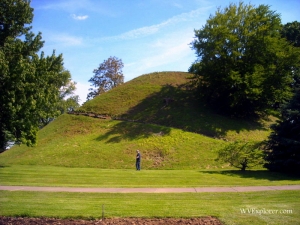
The Grave Creek Mound at Moundsville, West Virginia, in Marshall County, is one of the largest conical burial mounds in the U.S. Rising 62 feet and at 240 feet in diameter, it was the dominant landmark in complex of many more mounds and earthworks otherwise destroyed during European settlement.
The mound-builders, members of the Adena culture, moved more than 60,000 tons of dirt to raise it between 250 and 150 B.C. The largest surviving mound among those built by the Adena, the Grave Creek site has been designated a National Historic Landmark. Present-day Moundsville developed around it on a plateau area overlooking the Ohio River.
Adjacent to the mound, the Delf Norona Museum displays numerous artifacts that interpret the Adena culture. The U.S. Army Corps of Engineers in 2010 gifted to the museum more than 400,000 artifacts recovered in archaeological excavations at the site of the Marmet Locks near Marmet, West Virginia, which represent 10,000 years of indigenous habitation.




